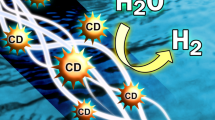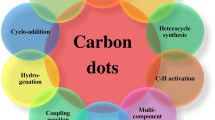Abstract
Transition metal-free oxidation of alcohols catalyzed by carbon quantum dots (CQDs) with NaClO oxidant using water as an only solvent was developed. High quality CQDs were synthesized via a simple one-pot electrochemistry method using cheap graphite rod as substrate materials, without the assistance of any chemicals but only pure water. The morphologies and composition of the resulting catalyst were characterized in detail. The results indicated that the CQDs catalyst showed higher activity and selectivity comparing to other carbon based transition metal-free catalyst (such as carbon nanotubes, graphene et al.) in the selective oxidation of alcohols to aldehydes. The high performance of the CQDs can be mainly attributed to its small particle size and large amounts of surface oxygen containing groups. The CQDs catalyst can be reused five times without any significant loss in their catalytic activities.
Graphical Abstract





Similar content being viewed by others
References
Mallat T, Baiker A (2004) Oxidation of alcohols with molecular oxygen on solid catalysts. Chem Rev 104:3037–3058
Paraskevopoulou P, Psaroudakis N, Koinis S, Stavropoulos P, Mertis K (2005) Catalytic selective oxidation of benzyl alcohols to aldehydes with rhenium complexes. J Mol Catal A Chem 240:27–32
Li G, Enache DI, Edwards J, Carley AF, Knight DW, Hutchings GJ (2006) Solvent-free oxidation of benzyl alcohol with oxygen using zeolite-supported Au and Au-Pd catalysts. Catal Lett 110:7–13
Chen YT, Lim HM, Tang QH, Gao YT, Sun T, Yan QY, Yang YH (2010) Solvent-free aerobic oxidation of benzyl alcohol over Pd monometallic and Au-Pd bimetallic catalysts supported on SBA-16 mesoporous molecular sieves. Appl Catal A Gen 380:55–65
Zhan GW, Huang JL, Du MM, Sun DH, Abdul-Rauf I, Lin WS, Hong YL, Li QB (2012) Liquid phase oxidation of benzyl alcohol to benzaldehyde with novel uncalcined bioreduction Au catalysts: high activity and durability. Chem Eng J 187:232–238
Dijksman A, Marino-Gonzalez A, Payeras AMI, Arends I, Sheldon RA (2001) Efficient and selective aerobic oxidation of alcohols into aldehydes and ketones using ruthenium/TEMPO as the catalytic system. J Am Chem Soc 123:6826–6833
Villa A, Wang D, Dimitratos N, Su DS, Trevisan V, Prati L (2010) Pd on carbon nanotubes for liquid phase alcohol oxidation. Catal Today 150:8–15
Yamamoto R, Sawayama Y, Shibahara H, Ichihashi Y, Nishiyama S, Tsuruya S (2005) Promoted partial oxidation activity of supported Ag catalysts in the gas-phase catalytic oxidation of benzyl alcohol. J Catal 234:308–317
Choudhary VR, Dhar A, Jana P, Jha R, Uphade BS (2005) A green process for chlorine-free benzaldehyde from the solvent-free oxidation of benzyl alcohol with molecular oxygen over a supported nano-size gold catalyst. Green Chem 7:768–770
Fu XB, Yu H, Peng F, Wang HJ, Qian Y (2007) Facile preparation of RuO2/CNT catalyst by a homogenous oxidation precipitation method and its catalytic performance. Appl Catal A Gen 321:190–197
Fu XB, Feng JY, Wang HA, Ng KM (2010) Fast synthesis and formation mechanism of gamma-MnO2 hollow nanospheres for aerobic oxidation of alcohols. Mater Res Bull 45:1218–1223
Qi L, Qi XY, Wang J, Zheng LW (2011) A synergistic effect in the combination of H(2)O(2), FeAPO-5 and NaBr for selective oxidation of benzyl alcohols. Catal Commun 16:225–228
Serp P, Corrias M, Kalck P (2003) Carbon nanotubes and nanofibers in catalysis. Appl Catal A Gen 253:337–358
Serp P, Castillejos E (2010) Catalysis in carbon nanotubes. ChemCatChem 2:41–47
Dreyer DR, Jia HP, Bielawski CW (2010) Graphene oxide: a convenient carbocatalyst for facilitating oxidation and hydration reactions. Angew Chem Int Edit 49:6813–6816
Machado BF, Serp P (2012) Graphene-based materials for catalysis. Catal Sci Technol 2:54–75
Zhang J, Liu X, Blume R, Zhang AH, Schlogl R, Su DS (2008) Surface-modified carbon nanotubes catalyze oxidative dehydrogenation of n-butane. Science 322:73–77
Luo J, Yu H, Wang HJ, Wang HH, Peng F (2014) Aerobic oxidation of benzyl alcohol to benzaldehyde catalyzed by carbon nanotubes without any promoter. Chem Eng J 240:434–442
Qin XY, Lu WB, Asiri AM, Al-Youbi AO, Sun XP (2013) Green, low-cost synthesis of photoluminescent carbon dots by hydrothermal treatment of willow bark and their application as an effective photocatalyst for fabricating Au nanoparticles-reduced graphene oxide nanocomposites for glucose detection. Catal Sci Technol 3:1027–1035
Ma Z, Ming H, Huang H, Liu Y, Kang ZH (2012) One-step ultrasonic synthesis of fluorescent N-doped carbon dots from glucose and their visible-light sensitive photocatalytic ability. New J Chem 36:861–864
Li HT, Sun CH, Ali MT, Zhou FL, Zhang XY, MacFarlane DR (2015) Sulfated carbon quantum dots as efficient visible-light switchable acid catalysts for room-temperature ring-opening reactions. Angew Chem Int Edit 54:8420–8424
Mirtchev P, Henderson EJ, Soheilnia N, Yip CM, Ozin GA (2012) Solution phase synthesis of carbon quantum dots as sensitizers for nanocrystalline TiO2 solar cells. J Mater Chem 22:1265–1269
Jaiswal A, Ghosh SS, Chattopadhyay A (2012) One step synthesis of C-dots by microwave mediated caramelization of poly(ethylene glycol). Chem Commun 48:407–409
Goh EJ, Kim KS, Kim YR, Jung HS, Beack S, Kong WH, Scarcelli G, Yun SH, Hahn SK (2012) Bioimaging of hyaluronic acid derivatives using nanosized carbon dots. Biomacromolecules 13:2554–2561
Shih ZY, Periasamy AP, Hsu PC, Chang HT (2013) Synthesis and catalysis of copper sulfide/carbon nanodots for oxygen reduction in direct methanol fuel cells. Appl Catal B Environ 132:363–369
Baker SN, Baker GA (2010) Luminescent carbon nanodots: emergent nanolights. Angew Chem Int Edit 49:6726–6744
Sun YP, Zhou B, Lin Y, Wang W, Fernando KAS, Pathak P, Meziani MJ, Harruff BA, Wang X, Wang HF, Luo PJG, Yang H, Kose ME, Chen BL, Veca LM, Xie SY (2006) Quantum-sized carbon dots for bright and colorful photoluminescence. J Am Chem Soc 128:7756–7757
Lu J, Yang JX, Wang JZ, Lim AL, Wang S, Loh KP (2009) One-pot synthesis of fluorescent carbon nanoribbons, nanoparticles, and graphene by the exfoliation of graphite in ionic liquids. ACS Nano 3:2367–2375
Li Y, Zhao Y, Cheng HH, Hu Y, Shi GQ, Dai LM, Qu LT (2012) Nitrogen-doped graphene quantum dots with oxygen-rich functional groups. J Am Chem Soc 134:15–18
Ji HB, Shi DP, Shao M, Li Z, Wang LF (2005) Transition metal-free and substrate-selective oxidation of alcohols using water as an only solvent in the presence of beta-cyclodextrin. Tetrahedron Lett 46:2517–2520
Acknowledgments
The authors are grateful to the supports from Natural Science Foundation of Guangdong Province (No. 2014A030313628), National Natural Science Foundation of China (No. 21306061).
Author information
Authors and Affiliations
Corresponding author
Rights and permissions
About this article
Cite this article
Zhang, X., Fu, X., Zhang, Y. et al. Transition Metal-Free Carbon Quantum Dots for Selective Liquid Phase Oxidation of Alcohols Using Water as an Only Solvent. Catal Lett 146, 945–950 (2016). https://doi.org/10.1007/s10562-016-1714-9
Received:
Accepted:
Published:
Issue Date:
DOI: https://doi.org/10.1007/s10562-016-1714-9




